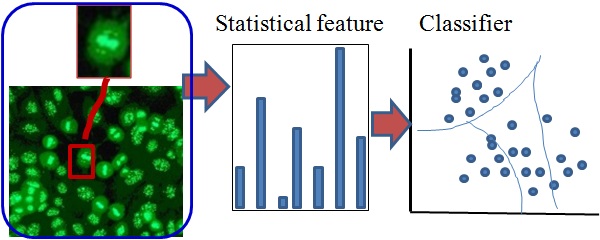Xian-Hua Han, Jian Wang, Gang Xu and Yen-Wei Chen, Ritsumeikan University, Japan
Volume 61, Issue 8, Page: 2223-2234

Indirect Immunofluorescence (IIF) is widely utilized as a diagnostic tool via image analysis, which can reveal the presence of autoimmune diseases by finding antibodies in the patient serum. In IIF, the human larynx carcinoma (HEp-2) substrate, which bonds with serum antibodies, thus forming a molecular complex, is applied, and recognition of the HEp-2 cell pattern can then be used to identify antinuclear autoantibodies (ANA). This study addresses to develop an automatic classification system of the HEp-2 cell using indirect immunofluorescent (IIF) image analysis. Generally, the method used for IIF analysis remains subjective, and depends too heavily on the experience and expertise of the physician. Recently, studies have shown that it is possible to identify the cell patterns using IIF image analysis and machine learning techniques. However, it still has large gap in recognition rates to the physical experts’ one. This paper explores an approach in which the discriminative features of HEp-2 cell images in IIF are extracted and then, the patterns of the HEp-2 cell are identified using machine learning techniques. Motivated by the progress in the research field of computer vision, as a result of which small local pixel pattern distributions can now be highly discriminative, the proposed strategy employs a parametric probability process to model local image patches (textons: microstructures in the cell image) and extract the higher-order statistics of the model parameters for the image description. The proposed strategy can adaptively characterize the micro-texton space of HEp-2 cell images as a generative probability model, and discover the parameters that yield a better fitting of the training space, which would lead to a more discriminant representation for the cell image. The simple linear support vector machine is used for cell pattern identification because of its low computational cost, in particular for large-scale datasets. Experiments using the open HEp-2 cell dataset used in the ICIP2013 contest validate that the proposed strategy can achieve a much better performance than the widely used local binary pattern (LBP) histogram and its extensions, Rotation Invariant Co-occurrence LBP (RICLBP) and Pairwise Rotation Invariant Co-occurrence LBP (PRICoLBP), and that the achieved recognition error rate is even very significantly below the observed intra-laboratory variability.
Keywords: HEp-2 cell, micro-texton, parametric probability model, mixture model of Gaussian, high-order statistics.

